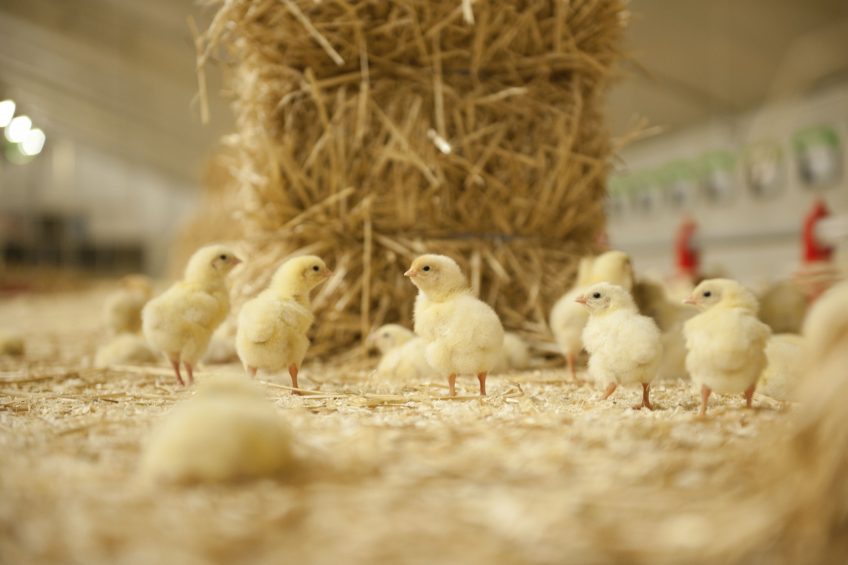Gut health without coccidiostats

As coccidiostats can induce bacterial resistance and may be banned as feed additives in the EU, alternatives are now being sought. Alpha-monoglycerides are able to overcome the negative effects on broiler performance caused by Eimeria and Clostridia and improve uniformity within the flock.
In the European Union 11 coccidiostats are approved to be used in broilers:
- 6 are ionophores and
- 5 are chemicals.
It is well known that ionophore coccidiostats also have antibacterial effects. Scientific studies show that bacterial resistance and cross-resistance exist between ionophore coccidiostats, especially against enterococci. Furthermore, resistance of coccidia against all 11 coccidiostats has been reported.
Rotation and shuttle programmes are developed to reduce the risk of resistance and the presence of necrotic enteritis (NE). Indeed, the presence of a mild coccidiosis infection is a prerequisite to result in a necrosis of the intestinal mucosa by Clostridium perfringens. This can lead to a higher usage of therapeutic antibiotics.
Time for a replacement to coccidiostats
Coccidiostats were intended to be prohibited as a feed additive from 2012. However, vaccination and other feed additives tested could not fully replace the coccidiostats and the proposal was cast aside. Currently, EFSA is evaluating the use of coccidiostats as a feed additive again, as the expiry dates of authorisation come closer. A feed additive which can reduce the presence of C. perfringens and the negative health effects of NE in the absence of a coccidiostat would therefore be right on time.
Alpha-monoglycerides as an antimicrobial feed additive
Framelco has developed FRA Gut Balance Dry; a combination of α-monobutyrin, α-monopropionin, α-monocaprylin and α-monocaprin. The product is designed to stimulate overall gut health by inhibiting the growth of gram-negative and gram-positive bacteria. Alpha-monoglycerides have even shown to be active against an antibiotic resistant strain of Staphylococcus. Moreover, experiments have shown that α-monobutyrin can inhibit the growth of C. perfringens.
Alpha-monoglycerides are pH independent and will not dissociate in the neutral environment of the intestines and perform their antibacterial properties throughout the entire gastro-intestinal tract, which is important for optimal gut health.
Reducing Eimeria and Clostridia infection in broilers
In a challenge trial with Eimeria (10-fold overdose of Paracox-5 at day 18) and C. perfringens from the environment, the effects of FRA Gut Balance Dry and other feed additives were tested. A total of 4400 1-day-old broilers were divided over 5 groups with 11 repetitions of each 80 broilers.
The negative control group received no coccidiostats or feed additives. The positive control group received 70 ppm of Narasin in the grower feed.
Treatment group 1 received 3 kg of FRA Gut Balance Dry per ton of feed the first 14 days and 2.5 kg per ton of feed from day 15 till day 28.
Treatment group 2 and 3 received feed additive A and B respectively. At day 28 of age the foot pad lesions, FCR and growth were determined.
Figure 1. FCR and weight gain showed in a boxplot for the 5 experimental groups.

Improved feed conversion ratio
Figure 1 shows that the FCR is significantly improved in Treatment group 1 when adding α-monoglycerides to the diet compared to the negative control (1.350 vs 1.383, p=0.0038). This median is comparable with the FCR of the positive control group with Narasin (1.347).
No significant reduction in FCR was found when feed additive B was fed. Figure 1 also shows that feeding broilers α-monoglycerides resulted in the highest weight gain, expressed as median, compared to the other two feed additives. Also the final weight was more uniform in the group receiving FRA Gut Balance Dry.

Figure 2 shows that only Narasin and the α-monoglycerides reduced the foot pad lesion score from 5 till 0. Therefore, the results of FRA Gut Balance Dry were comparable with the positive effects of Narasin.












